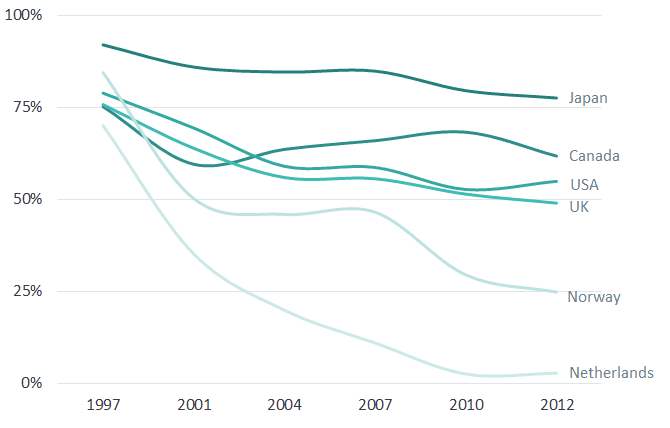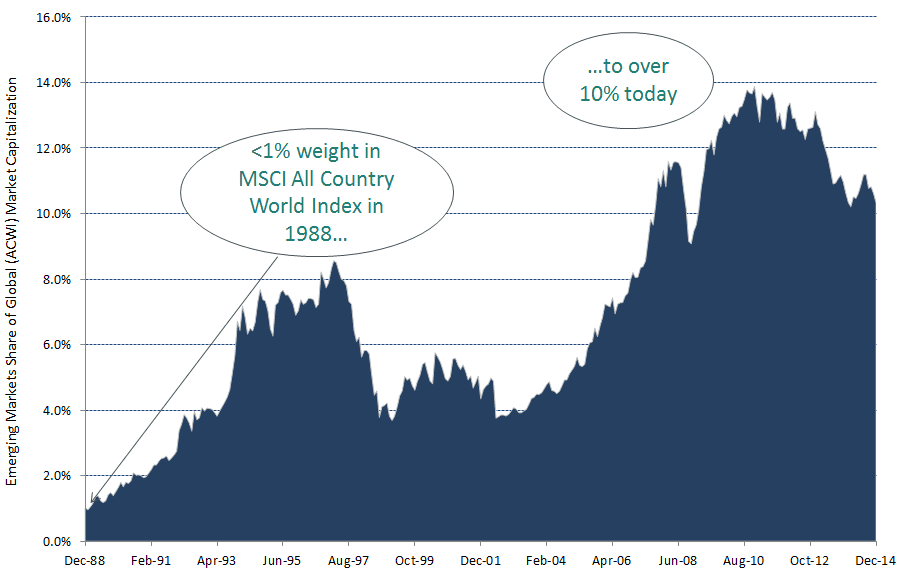Global Equity Allocation: A New Paradigm Developing
Blog post
April 29, 2015
Maintaining a "home bias" in the equity portfolio may come with huge opportunity costs.
In a 2012 study MSCI prepared for Norway's Ministry of Finance, we examined:
- The evolution of the global opportunity set
- The growing role of emerging markets in the global portfolio
- The use of Gross Domestic Product (GDP) weights to set country weights in the equity portfolio
Structural and Steady Decline in Equity Home Bias

Source: IMF (CPIS), MSCI. Home bias is defined as 1 - (actual international equity allocation / market-cap based international equity allocation)
When MSCI started calculating indexes in 1970, the global equity universe consisted of just 16 developed markets. In the 1980s, the launch of the MSCI Emerging Markets Index expanded the list to 35 countries. Frontier Markets and smaller companies subsequently were added, increasing the breadth and depth of the global opportunity set. The increasingly global nature of business and increased integration of financial markets have led to a marked convergence among regional equity markets, pushing investors toward an integrated global approach. Maintaining a home bias may come with potentially huge opportunity costs.
Since MSCI introduced its Emerging Markets Index in 1988, the weight of emerging markets in the MSCI ACWI Index has grown from less than 1% to more than 10% at the end of 2014 (see exhibit below). That figure would have been close to 30% if emerging markets were weighted by their economic weight instead of their market weight. In addition, as economies mature, their levels of GDP per capita tend to rise and domestic companies turn increasingly to stock markets to finance their expansion, thus boosting the presence of emerging markets in the MSCI ACWI Index. The risk, of course, is that the globalization trend may reverse.
This growth in emerging markets has led to a radical change in the opportunity set available to international investors. In today's equity universe, investors have the potential to tap into the world's regions with the strongest growth, often while adding stocks with lower correlations to equity performance in their home markets. The main long-term risk is that the globalization trend may reverse, particularly in the short term. In addition, some investors worry about higher levels of volatility.
The growing opportunity set from emerging markets

Read the paper, "Global Equity Allocation."
Subscribe todayto have insights delivered to your inbox.
The content of this page is for informational purposes only and is intended for institutional professionals with the analytical resources and tools necessary to interpret any performance information. Nothing herein is intended to recommend any product, tool or service. For all references to laws, rules or regulations, please note that the information is provided “as is” and does not constitute legal advice or any binding interpretation. Any approach to comply with regulatory or policy initiatives should be discussed with your own legal counsel and/or the relevant competent authority, as needed.
